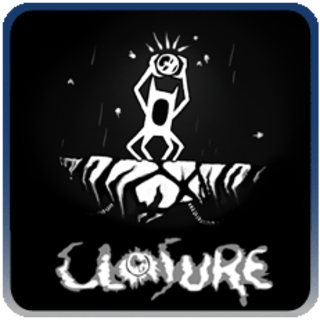INTRO:
In video game history, the end of the first decade of the 3rd millennium was marked by the rise of the indies, mainly due to fatigue about the all-too-familiar offerings by big-name game-makers. One characteristic of this era was the enthusiastic reception of anything that is different, and indie titles were certainly different during that time.
Closure was one such game. Unfortunately, when compared to the progress thus far in the indie scene, it has not aged well and hindsight would lead to plenty of critique that is not in its favour. Nevertheless, it has certain gameplay elements that are rarely seen in video games, even in the indie scene.
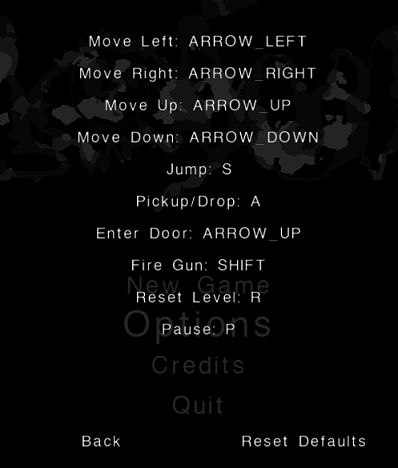
PREMISE:
With a name like “Closure”, one would think that this game is laden with clearly-expressed story-telling, but this is not the case.
There are several player characters. The main one is a six-limbed creature with pointy ears and a void for what is supposedly its face. It is moving about in a 2D surreal landscape where darkness is practically a different dimension of existence.
The creature appears to live in some weird place with doors. Upon opening any of the first set of doors, it morphs into one of three other player characters, which are all presumably humans, albeit heavily stylized. One of these looks like a miner with an oversized hard-hat, one looks like a little young girl and the third is a long-haired lady in a dress.
It is a bizarre set-up, initially. The creepy backgrounds imply that there is a narrative of sorts regarding emergencies or tragedies, especially on the part of the lady.
There is no text or voiced-over narrative whatsoever. Rather, the player has to figure out what the imageries mean.
GET TO THE EXIT:
The main goal in any scene of this game is to find the exit door and use it to leave. Along the way, there are obstacles that the player needs to remove or otherwise work around. This is hardly anything new in puzzle platformers. However, there is a twist that this game has, and which it is remembered for.
OUT OF SIGHT, OUT OF MIND, OUT OF REALITY:
Darkness is pervasive throughout the game. Its oppressiveness is made all the more substantial when it casts any piece of the environment that it permeates to oblivion (pun intended). Any floor, ceiling or wall that is in the dark is simply not there and cannot be interacted with. This rule also extends to the exit doors.
Other things, including the player character, can move through the darkness without suffering any ill effects. However, the darkness does not shut down everything, as will be described shortly.
That said, experienced players with some knowledge of programming will recognize this as a clever combination of hitbox generation and illumination coverage. That the code for both can run simultaneously is a mark of the programmers’ skill.
LAW OF GRAVITY STILL APPLIES:
The darkness does not dispel gravity. Objects that are not cast into oblivion, including the player character, would just fall downwards when they are in the darkness. If the player character falls out of the screen, the scene reloads. If something that is important to the solution of the puzzle falls out, the player has to reload the scene sooner or later. In the case of important objects such as keys, the player character clearly expresses dismay or alarm.
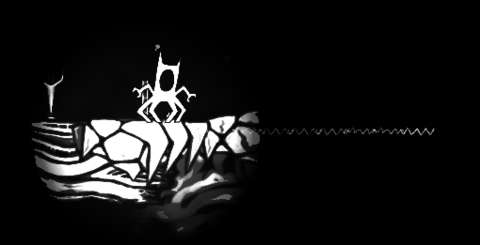
SHIFTING ILUMINATION:
An important part of any solution is to shift illumination about so that platforms that the player needs can exist.
The most common method of shifting illumination is to carry an orb of light around. There will be more descriptions of orbs later.
Another method is to rotate light fixtures (though what they are affixed to is unclear). The player will often do this in order to illuminate stretches of platforms that the player character needs to traverse through.
ORB PEDESTALS:
There are “pedestals” (according to the developer commentary) that can receive the orbs. There are a few types of pedestals, each with a different response to the receipt of an orb. The visual differences between them are not immediately noticeable, however, due to their simple shapes.
The first type duplicates the orb in another connected pedestal. In early and easy puzzles, this merely creates another platform that the player character can reach. In more complex puzzles, the player may have to quickly move an orb from one such pedestal to another in order to illuminate platforms and obstacles that prevent an object from falling into oblivion. In other puzzles, the player retrieves the duplicates of the orbs from other pedestals, which effectively removes the originals anyway.
The second type uses the orb to activate a moving source of illumination. The pedestal moves together with this source, even through solid obstacles. This effectively creates a moving platform. However, this platform is not a tangible platform, but rather merely parts of the environment that has been illuminated and made physical. The player character and other movable/portable objects do not have any traction with this platform, i.e. they do not move together with the platform.
The exception to this is when the illumination is moving upwards along a wall or obstacle, in which objects will move together with the illumination.
A string of dots indicates the path of the moving illumination, so the player can gauge where it would end. However, the end destination is not always illuminated.
KEYS:
Most exits are locked, thus requiring the player to find keys to unlock them. These keys are often located quite far away from the exits, and there are plenty of obstacles in the way too. The keys are also affected by gravity, and they do not respond well to being stacked on top of light orbs.
GETTING CRUSHED & BONKED:
There may be more than two mobile sources of illumination. Some of the scenarios with these may have the sources intersecting each other, possibly resulting in whatever that is caught between them being crushed.
A very rare cause of death is having the player character bonked on the head by some heavy falling objects. Of course, this can only happen in levels that have them. Considering that gravity does not do much harm on the player character, that this can happen does seem odd.
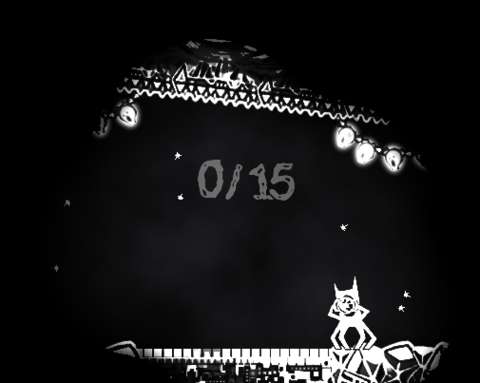
ORBS ARE FRAGILE:
As mentioned earlier, orbs of light are portable sources of light. They also happen to be a bit fragile. Although falls will not damage them, coming into contact with boxes that are being pushed into them will break them outright. This is something to keep in mind, especially in the solutions for the retrieval of the moths (more on these later).
FLOWERS:
There are flowers that response to the presence of other things.
The first strain of these are flowers that emit light in a radius. However, their petals will close when the player character comes too near them, thus plunging whatever that is around them into darkness. More often than not, the game uses these to complicate the player’s approach to puzzles. Still, observant players might notice a few peculiarities, like the illumination range of the flowers being slightly longer than the range for its detection of the player character.
The second strain of flowers only bloom if they are illuminated. The player would be having them bloom by placing light orbs next to them or adjusting lamps in their direction.
Fortunately, most levels would not have the player solving puzzles that involve both the second and first strains of flowers. That would have been frustratingly complicated.
WINDOWS:
Some objects in the environment let light go through, but are otherwise solid, thus preventing movement through them. These objects are often surrounded by drifting motes of light when they are illuminated.
ILLUMINATING OTHER ILLUMINATORS:
Not all sources of light are already activated. Some are dormant, waiting around somewhere in the darkness for another source of light to shine on them. Curiously, gravity does not affect them, but then that is because they do not exist yet.
Some of them give out light permanently when they are awakened. An example is any orb of light, and any artwork that the artist wants the player to see (but otherwise has no effect on the gameplay). Others merely redirect light that has been shone onto them, such as mirrors.
Both kinds can make for some tricky puzzles. For example, recently luminescent objects may realize obstacles that are in the way. Objects that redirect light require already-existing light sources to be shone on them, meaning that the sources could not be used on anything else.
(On the other hand, one of the screenshots in this review article shows an exploit in the coding for these light-redirecting objects.)
SWIMMING:
The toughest puzzles are likely those that involve water. Of course, they might not seem so at first, because water lets player characters float and sink at the player’s will, thus giving the player more control over their movement. Player characters also cannot drown while in water.
However, they can only swim in water that has been illuminated. If they swim out of this, they are no longer swimming and will be affected by gravity as usual. This can mean falling into oblivion. Furthermore, the player characters have to swim in tight paths that have been illuminated across the water, meaning that the player has to be deft at knowing when to make inputs and when not to so to avoid having the player characters drift out of the water.
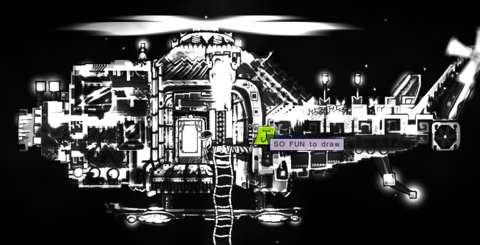
Generally, the player character cannot jump while in water. However, if the player has the player character sinking down onto a solid platform that happens to be in water, the player character can jump off the platform. This is something that is not shown by the game in any easy puzzle that has been deliberately designed to teach the player things.
OBJECTS FLOATING OR SINKING IN WATER:
Objects in illuminated water may sink or float. Their response to being immersed is an important part of puzzles.
Orbs of light always float, and there happen to be quite a number of puzzles that requires holding them up against obstacles so that they do not go too far away from the player character.
Crates and boxes also always float. There are many puzzles that require moving them about in water and removing illumination to make them fall. However, the player character cannot clamber up onto a floating box. He/She/It can only do so by finding a solid platform that is underwater and jumping off this onto the box.
Keys always sink. Indeed, many puzzles will require the player to find some means of preventing them from sinking too far, and then figuring out how to retrieve them.
Puzzles that involve having to manipulate objects in water are perhaps the most troublesome, because they require more timing and reflexes than lesser puzzles. Having to illuminate water is also a considerable challenge, because the player needs to illuminate enough for the player character to move about, while also letting the player character exit them at where it is convenient to do so.
SHOOTING:
The levels with the little girl introduces the turret. Presumably, it is firing B.B. rounds. It does not run out of ammunition and its projectiles travel very quickly. However, perhaps for the better, its appearance does not mean that the gameplay is going to change drastically.
Rather, the player has to shoot at bull’s-eye boards, which in turn somehow remove obstacles that are linked to them. Sometimes, the player has to remove other obstacles that are obstructing the line of fire of the turret.
Yet, it has to be mentioned here that this part of the gameplay could have benefited from the implementations from controls that utilize the mouse. Having to use the keyboard for these segments can be dissatisfying, especially in a scenario that has the player following the path of a moving light source and shooting any bull’s-eye board that is revealed.
SOME LEVELS ARE TOO BIG FOR THE CAMERA:
Some levels fit well in the size of the screen. Some others are big enough that the screen has to scroll from one segment of the levels to another. For most of these, this is not an issue because the puzzles in these levels have been segmented such that they can be solved within the same screen. The most that the player has to do in these levels is to get an object from one segment to another.
However, there are some levels that involve objects that the player character cannot hold and bring from one segment to another. Rather, the player has to manipulate things such that these objects fall, roll or otherwise move to another part of the level. This can be more difficult than it sounds, because of the physics-scripting that these things have.
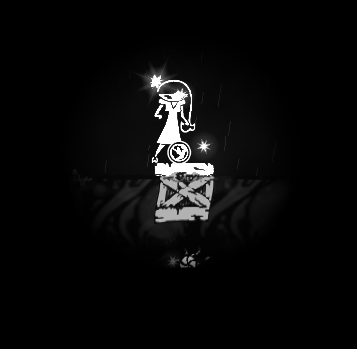
PHYSICS-SCRIPTING FOR BOXES:
Speaking of which, the most frustrating of these physics-scripts are those for boxes. At least the orbs and keys have predictable coding in their scripts, such as not having much sideways momentum and not getting any momentum imparted from the player character.
Boxes have sideways momentum. They also tumble and have inertia. Quite a number of the late-stage puzzles have the player trying to manipulate the unpleasantly unpredictable boxes. That said, here is a tip: where possible, have falling boxes fall into holes that are too small for them to pass through in order to prevent any tumbling.
MOTHS:
During the early years of the second decade of this millennium, there were few, if any, indie games that do not have some kind of collectible. Despite its lack of any easily comprehensible narrative, Closure has these too.
The developers refer to these as “moths”. Spectacularly luminescent moths are very rare, if there are any at all, in real life and in works of fiction. Pedantry aside, the moths are there to challenge the player. In order to register the collection of a moth, the moth must exit the level together with the player character.
Generally, the solution to getting them and then exiting with them is more complicated than the solution for just getting to the exit without collecting them. Many of these solutions require the player to exploit certain things about the game’s scripting on creating hitboxes for illuminated solids.
Moths appear in-game as flitting motes of light, which are also shedding other motes of light. These motes happen to fall downwards instead of drifting about, which make these moths easier to notice. However, these collectibles do not emit light of their own, and quite a number of them linger in the dark in the first place. They do make distinct twinkling noises though, so they can be heard if the player is keeping an ear out for them.
VISUAL DESIGNS:
Closure is entirely in grayscale, though it does use bloom and HDR lighting – perhaps too much of it. Although they would not cause frame rate stutter and luminance transitions are generally smooth, the lighting can actually place some strains on the CPU. This is mainly because the lighting also determines the hitboxes of objects, and the hitboxes have to be recalculated every time the lighting of the objects changes.
Peculiarly, there is not much of any casting of shadowing. Any apparent shadows on an object, such as the artwork in the background, are part of the details on the object. The shadows will never change their orientation no matter the lighting that the object gets. The most that the player would see are the objects becoming dimmer and their textures becoming less detailed as lighting is removed from them.
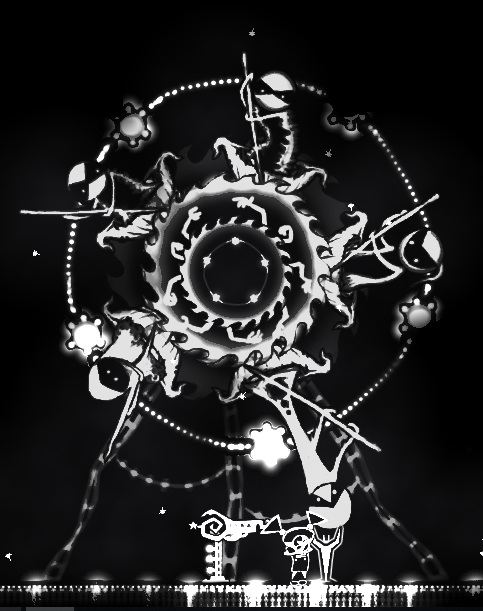
As for the artwork, most of it has been done such that objects are recognizable, though only just. The artwork is bizarre; an example is the artwork for the miner, whose head is his hard-hat. Nonetheless, most of the artwork is consistent enough so that objects that are important to puzzle solutions have silhouettes and other details that would eventually become familiar.
The artists try to produce artwork that is disturbing to look at. Examples include the fossils that are in the ground of the levels that are associated with the miner, and the hideous clowns in the levels that are associated with the little girl. However, this artwork is only ever in the background, not implemented in the gameplay and quite static. Their appeal would diminish quickly after the player realizes this.
SOUND DESIGNS:
The ominous music is the first thing that the player hears from the game. Ultimately though, it is just there for ambience; Closure does not have any theme of horror in its gameplay, despite its looks. Indeed, the player could just disable the music because it is just there to distract the player.
The sound effects are of greater worth to the gameplay. In particular, the player will want to listen for the sounds that are associated with the moths and the noise that can be heard when doors are unlocked.
There are no voice-overs, which is perhaps just as well because the game was not intended to have any immediately comprehensible narrative.
DEVELOPER COMMENTARY MODE:
Developer commentary has been implemented in the computer versions of the game. After completing the game at least once, the developer commentary mode unlocks. This is just as well, because this mode fetches assets from the levels, practically having the player replay them. However, additional controls have been implemented to let the player skip past levels.
The first and most immediately noticeable design of this mode is that there is colour. Specifically, there are sticky notes on-screen that are colour-coded according to the individual members of the development team. Even if the player is colour-blind, the sticky notes have initials on them so that they can be associated with the correct person.
Most of the sticky notes are about the level designs, controls and visual assets. Even so, most of them have meaning that is only clear in hindsight. Furthermore, there is little exposition on the intended narrative of the game.
The tool-tips of the sticky notes appear when the player character comes near them, or when the player hovers the mouse cursor over them. Indeed, this is the only part of the game where mouse controls are actually used.
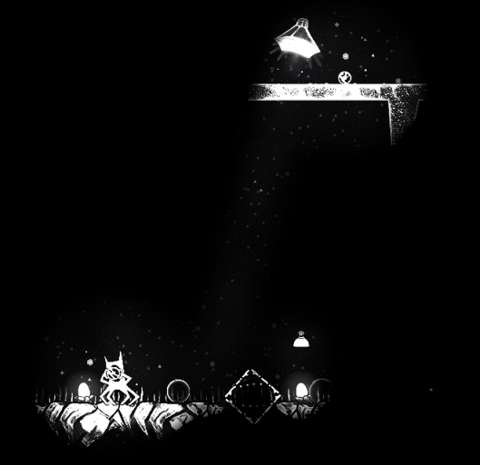
CONCLUSION:
In hindsight, Closure was one of those games that gained prominence mainly due to the indie craze in the turn of the first decade to the second of this millennium. Its lack of clear narrative, monochromatic presentation and artwork that does not contribute to the gameplay would have given the impression that it has aged poorly when it is evaluated in the present-day.
Moreover, it was hardly the only puzzle platformer around and in the years that followed its release. There have been so many puzzle platformers about negotiating obstacles and getting to the exit such that Closure would not seem so remarkable anymore.
Yet, it still is, mainly because of its use of a gameplay mechanism that has yet to be replicated in many games. (A not-entirely similar example is a later indie title, The Swapper, but it uses illumination for things other than hitbox generation.) Combining hitbox generation with illumination is apparently no easy feat, even among games with two-dimensional environments.
